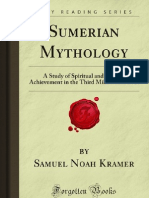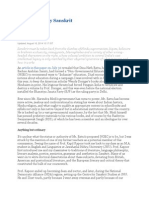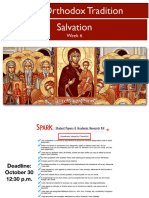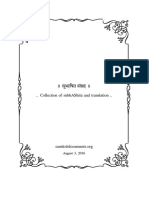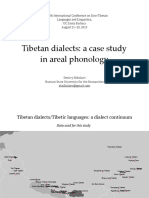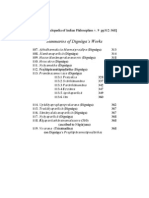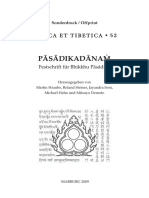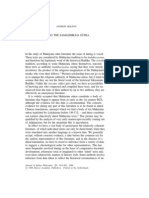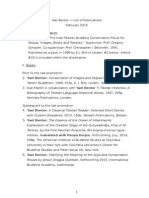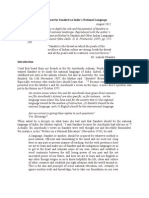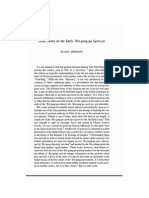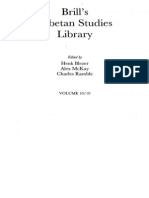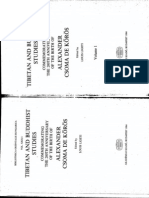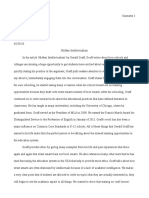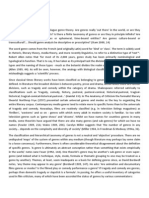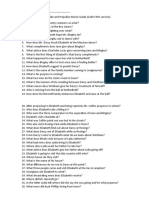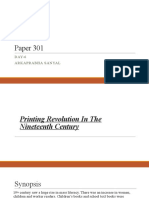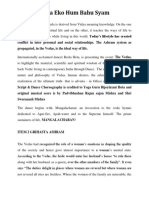Wayman 1972
Wayman 1972
Uploaded by
bodhi86Copyright:
Available Formats
Wayman 1972
Wayman 1972
Uploaded by
bodhi86Original Description:
Copyright
Available Formats
Share this document
Did you find this document useful?
Is this content inappropriate?
Copyright:
Available Formats
Wayman 1972
Wayman 1972
Uploaded by
bodhi86Copyright:
Available Formats
OBSERVATIONS ON TRANSLATION FROM THE CLASSICAL TIBETAN LANGUAGE INTO EUROPEAN LANGUAGES
by ALEX WAYMAN
Columbia University in the City of New York
An increasing number of scholars are turning their attention to Tibetan studies, some having properly come to imagine by the relatively few translations of major works that there are untold riches of religious literature in the Tibetan language. The difficulty of these works, replete with subtle Buddhist terminology, raises a serious question about the ideals and standards of translation that should be employed. It is there. fore appropriate to devote an essay to clarify certain actualities of such translation endeavor. The discussion will proceed under these headings: A. The Tibetan Language: Generalities; B. Some Principles of Translating from Classical Tibetan; C. The Introductory Counsel of the Sarvarahasya-tantra; D. Tsofi-kha-pa's "Auspicious Preparation"; E. Apropos Translation of Some Madhyamika Passages.
A. THE TIBETAN LANGUAGE: GENERALITIES All the Asian languages have their difficulties regarding translation into European languages. Tibetan shares with Chinese (they are the socalled "monosyllabic" languages) the feature that just learning the grammatical rules - - although essential - - does not get one very far in the classical language. One must read a lot of these languages, enjoy doing so, and reproduce passages whenever possible. Researchers into Tibetan literature were further handicapped for a long time by inadequate reference works and scarcity of instructional centers; fortunately there has been considerable improvement on this score in recent years.~ Classical Tibetan has a peculiarity that it is full of standardized terms dating back to the early ninth century composition of the Sanskrit1 Cf. W. Simon, "Tibetan Lexicographyand EtymologicalResearch", Transactions of the Philological Society, 1964, pp. 85-107.
162
ALEX WAYMAN
T i b e t a n d i c t i o n a r y called the Mahf~vyutpatti. T h e texts o f the T i b e t a n B u d d h i s t canon, t r a n s l a t e d a l m o s t entirely f r o m Sanskrit in a strictly literal fashion ~ a n d g r o u p e d into the two collections called the Kanjur a n d Tanjur, have a s o m e w h a t artificial c h a r a c t e r o f language. T h e r e is the a d v a n t a g e t h a t learned T i b e t a n s have r e a d these c a n o n i c a l texts century after century with g o o d u n d e r s t a n d i n g , while their s p o k e n language c h a n g e d 2 But the t r a n s l a t o r G u e n t h e r writes, "... I have tried to r e m a i n as close as possible to the associations these terms evoke in s p o k e n T i b e t a n a n d to the ideas they c o n v e y to the T i b e t a n listener. ''4 H o w ever, when m y wife a n d I were in D h a r m s a l a in Spring 1970, Mrs. P e m a G y a l p o , 5 sister o f His Holiness the D a l a i L a m a , r e p e a t e d to visitors t h a t her c o m m a n d o f s p o k e n T i b e t a n has n o t helped h e r in the slightest to u n d e r s t a n d a n y T i b e t a n B u d d h i s t text. O f course, ability in s p o k e n T i b e t a n enables one to c o m m u n i c a t e with a native s p e a k e r ; a n d if t h a t native is an expert on a p a r t i c u l a r subject, one can derive m o r e i n f o r m a tion, say o n a B u d d h i s t text. T h a t c o m m u n i c a t i o n is generally a w o n d e r ful thing for h u m a n relations, b u t the p r o b l e m o f translating the technical w o r k s o f B u d d h i s m is a different matter. A T i b e t a n m o n k s h o u l d n o t Long ago I found out, in the course of preparing the work Analysis of the Sr~vakabMtmi Manuscript (Berkeley, 1961), that the Yogacarabh~tmiversions in both Tibetan and Chinese translations of Asafiga's work are so literally close to each other by avoiding any extra expressions, that one could set up a fractional proportion between the two texts and accordingly from the place in the Tibetan translation predict very closely the equivalent spot in Hsiian-tsang's Chinese translation. Cf. Nils Simonsson, Indo-tibetische Smdien (Uppsala, 1957), regarding some of the methods of translation into Tibetan from the Sanskrit language. Among glossaries that expose these translation methods, especially noteworthy is Friedrich Weller's Tibetisch-Sanskritischer Index zum Bodhicary6vatara, Heft I (Berlin, 1952) and Heft II (Berlin, 1955). Also worth mentioning is Gadjin M. Nagao's Index to the Mahayana-SMralarhkdra, Part One (Tokyo, 1958) and Part Two (Tokyo, 1961). 3 The grand lama of Mongolia named Dilowa Gegen Hutukhtu once told the present writer in Berkeley, California, that he had never read the Bodhi Miir, the Mongolian translation of Tsofi-kha-pa's Lain rim chen rno, by the founder of his sect, although of course he had read the work in the original Tibetan, and although his native spoken language was Mongolian. Classical Tibetan became a sacerdotal language in which the sacred scriptures of Tibetan Buddhism were studied by Tibetan and Mongolian monks, and even at times by some Chinese Buddhists. As such, it was clearly independent of modern spoken languages. Herbert V. Guenther, The Royal Song of Saraha (Seattle, 1969), p. vi. This single report from a Tibetan is not necessary to disprove Dr. Guenther's thesis about the spoken language, which is baseless on other grounds (cf. n. 3, above). However, I cannot emphasize too strongly that, despite his insistence, the Tibetan spoken language is not responsible, e.g. for his preference of the inappropriate word "motility" over "wind" to translate Tibetan rlu~ (Skt. vayu) in The Life and Teachings of N6ropa (Oxford, 1963). And since the word vayu is frequently used in the plural, for example, in the Tantric doctrines descended from the old Upani.sads about these "winds", the word "motility" appears even more awkward.
TRANSLATIONOF CLASSICALTIBETAN
163
be held responsible for the possession, or tack of competency in the classical Tibetan language by the translators or would-be translators. That is, a mere elementary ability to read the classical Tibetan language is not compensated for by talking to a native. 6 As a measure of adequate training in the classical language, there is the Japanese photographic reprint of the Peking edition of the Tibetan canonY This edition in Western format is of extraordinary value for research. Yet I have heard a criticism that there are many unreadable spots. For the most part, this criticism can be discounted. The photographic reduction has practically obliterated the separating dots between the Tibetan syllables. But anyone sk_illed in reading Tibetan does not depend on those dots, so much of that criticism is an unwitting confession of insufficient skill. Thus, to read classical Tibetan of the canonical type, one should have recognition of Tibetan compounds and typical phrases to ensure that the mere nonvisibility of those separating dots does not impair the utilization of a text. The translator should be aware of the nature of Tibetan Buddhism. It has been predominantly a commentarial or lineage-oriented religion. The educated Tibetan Buddhist monk ordinarily would not claim proficiency in any primary text, particularly one in verse form - - like the Abhisamay~la.mk~ra of the Praj~@~ramit~ literature - - unless he had sufficiently studied the commentarial exegesis of that text. In practice this meant that a number of Kanjur texts with no available commentaries in the Tanjur were hardly read at all, because the monks could not trust themselves to understand those works under such circumstances. It is not that they are incapable of understanding isolated texts; rather it is a case of lacking lineage permission. Therefore, it is not necessary, as has sometimes been tried, to reconstruct the 'original' Sanskrit of the Tibetan translated from Sanskrit. s 6 Let this point not be misconstrued! Students of the Tibetan language should try to meet and communicate with learned Tibetan natives. The principle here being alluded to holds in a wider context but especially with Asian languages. It has frequently happened that a Westerner with a smattering of an Asian language thinks he can collaborate with a native who knows a little of his European language, to translate a work into his own European language. This is folly. For example, a Tibetan monk should not have to vouch for the English equivalents of Buddhist words if the translation is into English, let alone English syntax. 7 The Tibetan Tripitaka, Peking edition .... repr. under the supervision of the Otani University, Kyoto, vols. 1-168 (Tokyo-Kyoto, 1955-1961), referred to by abbreviation PTT. s Of course, it is as proper to translate Tibetan into Sanskrit as into any other language, and what was sometimes termed "reconstruction" was in fact a translation back into Sanskrit, the language from which the Tibetan text had been translated.
164
ALEX WAYMAN
Aside from the fact that it is virtually impossible to reconstruct exactly, the thesis that it is necessary reduces to the absurdity that the Tibetans cannot understand any of those passages for want of reconstructing the equivalent Sanskrit. But in fact it shows that the translator does not know classical Tibetan as an independent language. On the other hand, since the canon was translated from Sanskrit, a translator should consult such a reference work as the MahSvyutpatti which establishes the Sanskrit-Tibetan equivalences for technical terms. That is, he need not pretend that these technical terms in Tibetan have a special significance in themselves independent of the connotation of appearing repeatedly in Buddhist works translated from Sanskrit. In addition to that canon, eventually a native Buddhist literature arose with styles of writing quite different from what is encountered in the Kanjur and Tanjur and reflecting the views of the various Tibetan sects. In fact, native Tibetan writing has special problems for the translator that he does not ordinarily encounter in translating material from the canon. In this case, it is quite a different matter to translate works of one rather than another Tibetan school. In the case of the Gelugpa sect, founded by Tsofl-kha-pa (1357-1419), the little text by him translated in this essay will clearly show how his school is founded on the Tibetan equivalences of Sanskrit Buddhism. Therefore, when translating works of this school, it is again necessary to bear in mind the established Sanskrit-Tibetan terms, as though one were reading Kanjur or Tanjur texts. However, when it comes to other Tibetan sects where other influences may have entered in, it may not be the ease that important terms reflect Sanskrit Buddhist originals. The translators who work on texts of Tibetan sects other than the Gelugpa can decide on that for themselves in consultation with the learned Tibetans of those particular traditions?
So far the kinds of Tibetan books translated into European languages have been either works popular among all Tibetans, such as the Gesar Saga, the Tibetan Book of the Dead, Milarepa, and The Blue Annals; or works of the Rfiifl-ma-pa (the old sect) and the Bka'-Brgyud-pa, such as Padmasa .mbhava, the Sri-Cakrasar0vara texts published as Vol. VII of Arthur Avalon's Tantra series, and Sgam-po-pa; and even works of the Bon-po - - in contrast with works of the Gelugpa sect, although much is known of Tsofl-kha-pa's life. The reason is that, prior to the recent exodus from Tibet of learned monks, Westerners such as W. Y. Evans-Wentz who contacted Tibetans near the Tibetan border on the Indian side, generally had good relations with representatives of sects other than the Gelugpa. Since the Gelugpa was the predominant sect in Central Tibet and had political control there, the other sects often did not speak well of the Gelugpa in conversations with Westerners; this went hand in hand with a certain aloofness of Gelugpa monks, especially since the usual Westerner was fascinated with Tantra rather than with Buddhism itself. So it turned
TRANSLATIONOF CLASSICALTIBETAN
165
In subsequent sections, I shall present some principles of translation from Tibetan, and then illustrate those principles, first by the kind of text which needs a commentary, then the kind which needs help from a native. Finally, some practical examples from M:dhyamika-type texts will be considered for evaluating purposes. There is the formality of transcription from Tibetan. Here I have accepted the Tibetan romanization table adopted by the Library o f Congress. :~ B. SOME PRINCIPLES OF TRANSLATION FROM CLASSICAL TIBETAN 1. Grouping o f translators Here there is a triadic grouping and a twofold grouping. A number of important issues about translation of Buddhist works have been well stated by Ruegg:: in the course of considering Guenther's The Jewel Ornament o f Liberation. Among other observations, Ruegg places translators of Buddhist works in three groups, to wit, those with extreme literalness (especially S. L6vi), those in the opposite camp of interpretive translation (especially Th. Stcherbatsky and H. Guenther), and those with a middle-of-the-road method (e.g. de La Vall6e Poussin, 1~. Lamotte, E. Conze). The two extreme groups deserve some discussion. O f course de La Vall~e Poussin was right in criticizing L6vi's French translation of the Sf~tr~lam. k~ra as unintelligible. 12 However, in order to understand the situation, we should recognize that L6vi did not originate the unintelligibility. The basic verses of the S~trdla.mkdra are out that the Lessing-Wayman translation of Mkhas grub rje's Fundamentals of the Buddhist Tantras is the first example of an important Gelugpa text to appear in a European language. 10 The table for the Tibetan language that was approved by the American Library Association, the Canadian Library Association, and the Library of Congress, was published in the Library of Congress, Cataloging Service, Bulletin 90, Washington, D.C., September 1970. The Library of Congress has a procurement service office in Delhi furnishing pre-catalogued Indian books to subscribing American universities. Mr. Gene Smith, who works in that Delhi office, has rendered excellent service by cataloging the newly printed Tibetan books in accordance with that table for the Tibetan language. 11 David Seyford Ruegg, "APropos of a Recent Contribution to Tibetan and Buddhist Studies", Journal of the American Oriental Society, Vol. 82, No. 3 (July-Sept., 1962), pp. 320-331. Dr. Ruegg shows his own fine standard of translation from Tibetan/n La thdorie du Tathagatagarbha et du Gotra (Paris, 1969); and when, as in this case, the many citations from different Tibetan books are prevalently on the same topic, they help each other in the understanding by reason of consistency in terminology. :~ Cf. Ruegg, "APropos", p. 325, n. 10.
166
ALEXWAYMAN
indeed unintelligible, in fact often just lists of technical terms grouped under subject headings. Asaflga's prose commentary, which L6vi edited, reduced the unintelligibility of the original verses. But apparently Asafiga's brief remarks did not clear that up sufficiently, because in time Sthiramati wrote a huge sub-commentary to try to finish the job. (Notice that Asatiga, or in the next remove Sthiramati, does not comment by replacing words of the basic text, but rather by defining or expanding upon them). Thus, if L6vi had translated in such a way as to avoid unintelligibility, it could be argued that he was not faithful to the words of the original work. In short, the attempt to render intelligible in another language what is difficult and obscure in the original can sometimes introduce elements quite at variance with the intentions of the original work. As Ruegg points out, clarifying remarks should be added (say in brackets) to, rather than replace the basic term. At the other extreme of interpretive translation, Stcherbatsky might have protested being grouped with Dr. Guenther, arguing that he (Stcherbatsky) feels free to make syntactical rearrangements when translating, while Dr. Guenther's freedom is in rendering the technical terms themselves. Some years ago I copied out the Tibetan which Stcherbatsky had published of Dharmakirti's Nygtyabindu, minus Dharmottara's commentary, and correlated each of the aphorisms with his English translation. When I compare the Tibetan with his translation, it turns out that he adheres quite closely and puts commentarial expansion in parentheses. For example, here is Ny6yabindu, Chap. II, 27, in Tibetan, with his translation influenced by Dharmottara: dhos po yod na ni de mi srid pa'i phyir ro. "Because when a real object is present (it is perceived and it) becomes superfluous (to imagine its presence)." The second "it" should have been outside the parentheses because it is actually represented by the Tibetan (de). On the other hand, my spot checks indicate that Stcherbatsky is more free in translations from the Prasannapad~ (in his The Conception of Buddhist Nirv~n.a). About terms, we can see the situation in Stcherbatsky's student, Dr. E. Obermiller, who explains the three bodies of Buddha as the sa.mbhoga-k6ya ~ the Body of Bliss - - Buddha in the heaven Akani.st.ha, nirm6n,a-k~ya - - the Incarnate Form (in the person of g~kyamuni, etc.), and dharma-k~ya the Cosmical Body, representing the Universe sub specie aeternitatis (in the last case, adopting Stcherbatsky's rendition). 13 So far we are obviously in Buddhism, of the Mah~ygna variety. When we pass to 1~ Dr. E. Obermiller, History of Buddhism by Bu-ston, Part I (Heidelberg, 1931), pp. 138-39, n. 4.
TRANSLATION OF CLASSICAL TIBETAN
167
Guenther's "noetic being" for dharma-kaya; "communicative being" for sa.mbhoga-k~ya; and "authentic being" for nirmt.na-k6ya, 14 we have a replacement of terms that is not immediately recognizable as Buddhist. By reference to Ratngkarag~nti's comments on the Sarvarahasya-tantra, verses 7-8 (see next section of this essay), we observe that Guenther's "noetic being" is based on the commentarial glosses on the term dharmakgtya. One would have to strain mightily to justify his "communicative being" from the Indian commentarial glosses on sa.mbhoga-kaya; and have to give up altogether finding an Indian justification of his "authentic being" for the nirm~a-k~ya. The twofold grouping amounts to the set of initial translators and the set of supplanting translators. One cannot avoid this issue of translation and retranslation. It is peculiar that so many scholars are reluctant to approach an Asian classic that has not hitherto been rendered into a European language. Often this reflects lack of imagination or good advice, or possibly even confidence. However, there is a legitimate function of retranslation. The late Richard Robinson had a genuine ability to retranslate Chinese Buddhist selections, as when he did this with some passages that had already been translated by Liebenthal. 15 It is my own observation that scholars who engage in the supplanting type of retranslation feel uneasy about, and sometimes are openly hostile, to the scholars who are initial translators. The latter have had the courage to tackle a great classic, but through the very fact of thinking deeply over the words of the original, often their translation words in the European language - - even if it be their native language - - are not the most felicitous. The supplanting individual, relieved of the serious problems of approaching a difficult work for the first time, can easily notice places where he can employ more finesse.
14 Guenther, The Royal Song, p. 5. in F o r example, Walter Liebenthal, The Book of Chao (Peking, 1948), p. 60: "Therefore it is impossible to teach Absolute Truth (paramdrtha satya) by means of definitions. Then how can it be made the subject of writing? (It cannot). But I also cannot remain silent. In spite of (what I have just said) I shall state my opinion in speech and try to make it clear."; Walter Liebenthal, Chao Lun (Hong Kong, 1968), p. 56: "Therefore the sphere of Truth is beyond the noise of verbal teaching. How then can it be made a subject of discussion? Still I cannot remain silent. In spite of (what I have just said) I shall state my opinion and defend it."; Richard H. Robinson, Early M~dhyamika in India and China (Madison, 1967), p. 140: "Absolute Truth is a name, so it cannot be called a thing. The theory that names correspond to things does not apply to it. Nevertheless, though language cannot refer to it as an object of reference, I propose to talk about it." - - In the above, we have Liebenthal's original translation, then his own revised translation, and finally Robinson's rendition of the same passage as a presumed improvement over Liebenthal's first version,
168
ALBXWAYMAN
For his part, the usual Western reader would like to have a more graceful and transparent text because, after all, he is only going to read it; so he would probably prefer the supplanting retranslation.
2. Literal translation as suspended judgment
The literal nature of translation into Tibetan and Chinese had a great advantage over a freer form of translation by suspending judgment on the purport of the scripture. This becomes very important in the Tantras because this branch of literature uses many mystical terms that are not necessarily elucidated in the context of their occurrence. By a literal translation of such terms, one can approximate their mystery and leave it up to a subsequent time and study to determine their levels of significance. However, if one insists that a good translation of a text requires an intelligible rendition of every term, he puts the translator in the position of being a wiseacre, who "understands" the text before he has translated the whole of it or mastered the entire literature of which it is a part, and who is an authority on intelligibility although people differ in capacity to seize the meaning. This goes against the theory of understanding in three levels that has been basic to Buddhism since its inception. I allude to the three levels of praj~a (insight) called ~rutamaM praj~fi, cintamafl praj~6, and bhtvan~mayi-praj~?t. The literal translation is on the level of insight consisting of hearing (or learning), and should be succeeded by the subsequent stage of insight consisting of pondering. The translator who insists on making the entire sOtra intelligible even at the cost of departing from the words, introducing new material that does not correspond to the original text, and so on, is palming off his supposed "insight consisting of pondering" upon the unsuspecting reader. As Tsofl-kha-pa, in his Shags rim chen mo (Peking blockprint, f. 116a-3) (his great compendium of the stages of the tantric path) cites the author graddh~karavarman:
[ dab po ~an pa'i ges rab kyis ] [ tshig gi rgyud la thos pa bskyed / [ de nas bsams pa'i ges rab kyis / / tshig dab don du 'brel ba bslab / ] de nas bsgoms pa'i blo rtsal kyis / / dab por bskyedpa'i rim la bslab [ / de rjes rdzogs pa mthar dbyuh ste /
TRANSLATION OF CLASSICAL TIBETAN
169
First, by hearing insight he arouses the hearing of the Tantra of words. Then by pondering insight he learns to attach the meaning to the words. Thereupon, with skillful intellect that contemplates intensely, he first learns the Stage of Generation and after that fulfills the Stage of Completion. The first phase, searching for broad learning, was completed. Hence, the literal translation of the "S~tra of words" or "Tantra of words" goes with the translator's humility. If there is a scholarly pursuit to recover an old text in the role of what it meant to the persons who revered it, presumably a scholar cannot avoid the text in the sense of the words themselves, as that text is prior to the fuller understanding of it represented by paraphrase and exegesis. A good illustration of justifiably suspended judgment is the dispute over the meaning of the tantric term sa.mdha-bhr.sa. Now, the plodding, earth-bound translators who rely on the dictionary would think this means "twilight language", and this is the way it was rendered many years ago by MahSmahop~dhy~ya H. P. S~stri, whose fancy title will be seen as justified. But later scholars could see no reason why the particular expressions that were labelled sa~dha-bhr.sa should be called "twilight language", so (the logical consequence of their inability to see a reason) they tried to come up with a better translation. V. S. Sastri decided that these were expressions that intend something different from the words, and proposed the translation "intentional language" (although a native speaker of English would hardly get the sense "intending something else" from the word "intentional"). Note the procedure of arriving at this supposedly better translation: Someone works about in secondary materials, and then speculates about the word; and believing in his own intelligence, and that he can arrive at the truth of the matter thereby, announces what is indubitably the fact. Later, I wrote an article on the subject,le citing authorities on the Tantras, such as the tantric N~g~rjuna and the tantric Candrakirti, showing how these authorities use and explain the term. As a result, I had to conclude that the term meant just what it seemed to mean from the outset, "twilight language", but now clarified in usage as language expressed in the manner of twilight, expressed in an ambiguous and unclear manner. Of course, the word sa~dha (twilight) was employed metaphorically. But is there anything
xe Alex Wayman, "Concerning sa~ndh~-bh~ ] sa.mdhi-bh~.s~ / sa~dhy~ b h ~ " , Mdlanges d'lndianisme a la m~moire de Louis Renou (Paris, 1968), pp. 789-96. Along the lines of the findings in this article, when Mah~y~na scriptures use such terminology (in Tibetan: dgot~s nas ... bdad pa), one can render it variously as "speaking obscurely" or "speaking with ambiguity".
170
ALEX WAYMAN
wrong with metaphorical use of terms? If there is something wrong in this case, it is with the translator whose mind cannot respond to a metaphor, and so has to change it into something else, thus to hide obtuseness.
3. A Tibetan and Chinese translation of the term Tath~gatagarbha
When the Buddhist scripture called Sr~m?d~devisi~nhan6da-sfltra,17 an authority on the Tath~gatagarbha doctrine, was translated into Chinese and Tibetan, these languages adopted contrasting ways of translating the word garbha. The Chinese version translates garbha as "womb", the Tibetan with a term s~i~ po meaning "heart", "pith", "essence". The question arises: Does this mean that the reader of the Chinese scripture gains a different idea of the Tath~gatagarbha doctrine than does the Tibetan reader of the Tibetan form of the same scripture? Not necessarily, that is, not by virtue of the differing translation of the term tath?tgatagarbha, because this scripture makes important statements about that term, and so the difference in understanding - - if there is a difference - - would most likely come about in how different readers understand those sentences about the tathagatagarbha. In short, Buddhism was never taught by means of isolated words, but by precepts and more drawn-out explanations that contained and elucidated important words of the system. For this purpose, it is very important to be consistent in representation of a term, and so both Chinese and Tibetan emphasized a consistency in translation of certain important Buddhist terms. However, it could also be argued that a word with physiological sense, i.e. "womb", would color the sentence differently than a word with more abstract sense, i.e. "essence". This also does not follow necessarily. The reason is that the connotation of a word for "womb" in any language depends on other words. We do not know without further advice from intelligent native speakers and readers of a language whether they take such a word as "womb" in its concrete physiological sense or in various metaphorical levels. These more learned natives might respond that it depends on the sentence. They might mention that there are other books with information on the topic (in China and Tibet: other scriptures on the Tath~gatagarbha). In that case, we are back to the situation of the
1~ An annotated translation of this work by Alex Wayman and Hideko Wayman, with title The Lion's Roar of Queen ~rirnala, is in press of Columbia University Press.
TRANSLATIONOF CLASSICALTIBETAN
171
Buddhist sentence, which is first learned with faith, and later understood through pondering. It should be observed that both the Chinese and Tibetan agree in translating the term garbha by a chosen sense of the word as was well established in Indian usage, and can now be verified by reference works such as modern dictionaries. Neither the Chinese nor the Tibetan replaces the word garbha by some other non-corresponding term which the translators might deem to suit the context better. Therefore, in this case as well as elsewhere - - and whether or not the Chinese Buddhist understands the matter differently from the Tibetan m o n k - - the Chinese and Tibetan translations maintain a word consistency for "insight consisting of learning" (grutamayi prajg~).
C. THE INTRODUCTORY COUNSEL OF THE SARVARAHASYA-TANTRA The Sarvarahasya-tantra and its commentary by Ratn~kara~nti called the ~ri-sarvarahasya-nibandha-rahasyapradfpa-n~ma, are extant only in Tibetan translation, the former in the Kanjur and the latter in the Tanjur. is The first ten verses, constituting the introductory counsel, are here given in Tibetan translation, together with an English version of that and of extracts from Ratn~kara~gnti's commentary. It will be clear that the verses do not mean much when read by themselves without this commentarial expansion. Indeed, they would have been even more unintelligible if translated without the help of that commentary. However, in this case, because the commentary was available, it was not necessary to consult with a knowledgeable Tibetan. Since both the basic text and its commentary are of Indian origin, it is quite proper for a translation into a European language to restore some technical terms of the original Sanskrit as are certain by the well-known correspondences.
/ / / /
'byuh lha gid kyis lha yi bdag ~id can / mi rnams lus la hes par mthoh ba dag / rah seres rab tu sgoms par gyur na ni/ dhos der sgorns pas ries par saris rgyas 'gyur//
is I have employed the Peking edition, PTT, Vol. 5, pp. 56 to 60, for the basic Tantra; and PTT, Vol. 76, pp. 1 to 15, for Ratn~kara~mti's commentary. From my manuscript translation of this work, I have included another block of verses in the essay "Contributions on the Symbolism of the Mao..dala-Palace", Etudes tib~taines d~di~es la mdmoire de Marcelle Lalou (Paris, 1971).
172
ALEX WAYMAN
1. Certainly the men who observe the body by way of the five elements gain mastery of the five. And having contemplated their own mind, certainly their contemplation in that mode of being (bhava) leads to Buddhahood. Comm. : The five elements are earth, water, fire, wind, and space (~kaga). Those men observe the body to be like a mendicant's robe, and the mind to be like the wish-granting jewel (cint?tman.i).
/ raft ~es gsaft ba dam pa ni / / sans rgyas ye ges bla reed de / / ggis reed g~is kyi tshul can te / / sans rgyas rtag par rab tu 'dud//
2. The sublime secret of their own knowledge is the incomparable Buddha knowledge, nondual with the character of (appearing as) two, that the Buddhas always honor. Comm. : "Secret" because supramundane; "sublime" because best among the supramundane. One's own mind has the incomparable knowledge belonging to the Tath~gatas. Ordinary persons with adventitious defilements regard mistakenly the nondual knowledge as two, namely as subject and object. The Buddhas salute one's true mind (cittat6).
/ gab yah bdag reed las byun sin / / g~is reed ye ges las byun ba / / sdug daft mi sdug rnams spafts pa / / ci la'an phyag ni mi 'tshal to//
3. Who would not salute the one who avoids both the unpleasant that arises from nonself and the pleasant that arises from nondual knowledge? Comm." "What arises", i.e. as effect, from nonself or from the nondual knowledge. "Cause" is counted as one's own mind when taking any dharma as object, and is nonself in the sense of regarding as two. "Cause", as the nondual knowledge, brings everything to fulfilment. The "pleasant" means the dharmas to be acquired; "unpleasant" means the dharmas to be rejected. The one who avoids both attains the ultimate nature.
/ ma skyes pa ni yah dag bskyed / / skyes pa'i 'og tu rtag par ni/ / sans rgyas skur ni sgom pa de / / ran gi ye ges mchog phyag 'tshal/[
4. He rightly generates the unborn, and after its birth contemplates it as the eternal Buddha body, and salutes it as his own highest knowledge.
TRANSLATIONOF CLASSICALTIBETAN
173
Comm. : " U n b o r n " is the state of one's own mind when it is not involved with duality. And he "salutes" it with his own body, speech, and mind.
/ rnal 'byor pa dab seres can kun / / ma skyes pa ni yah dag bskyed / / skyes pa'i "og tu rtag par ni / / ~on mobs bag chags kyi sun 'byin//
5. The yogin - - and he is among all sentient beings - - rightly generates the unborn; and after birth is ever troubled by the habit-energies (vdsana) of defilement (klega). Comm.: Here the yoga is the nondual knowledge. The one who has it is the yogin. But the yogin is a m o n g the sentient beings who, after birth, are troubled in sa~s~ra.
/ lus can rnams ni 'khor gyur pa / / sdug dab mi sdug rnam 'byed yin / / seres gab de gid sdug bshal te / ] seres can rnams kyi lus 'byuti tio//
6. The embodied ones (dehin) in sa.msdra distinguish the pleasant and the unpleasant; and whichever one be thought indeed is the suffering that arises with the body of sentient beings. Comm. : The "pleasant" is abode, enjoyments, and so on. The "unpleasant" is the full comprehension which especially distinguishes those same things. F r o m those two comes the habit-energy of distinguishing the two. Thence, birth in sa.ms~ra with a body necessarily attended with suffering.
/ sems de yi ni rgyun ~id kyi / / 'gro ba sdug bshal gnon par 'gyur / / rnam par shah mdzad rgyal ba rngon / / sahs rgyas thams cad bsdus gcig pu// / salis rgyas thams cad rtogs gyur pa / / sahs rgyas 'khor ba sgrol ba po / / seres can kun la phan ba'i phyir / / thugs rje'i gains dab yah dag ldan//
7-8. The living being who has continuity of that consciousness suppresses suffering. He is Vairocana, the Victor (Jina), the Lord (Nfitha). He is the solitary one comprising all of the Buddha. He has become all that was comprehended by the Buddhas. He is the Buddha who rescues from sa~sdra, endowed with compassionate heart for the benefit of all sentient beings.
174
ALEX WAYMAN
Comm. : "Continuity", namely of the full comprehension which especially distinguishes, and this rescues from sa.msara. He is Vairocana, because he pervades everywhere with unimpeded and immaculate knowledge; the Victor, because he arouses enjoyment of D h a r m a in all aspects; the Lord because he performs the aim of living beings in every way. And these are respectively the Svabhgvak~ya [ = here the Dharmak~ya], the Sa .mbhogakgya, and the Nirm~n. ak~ya. "All of the Buddha" means all dharmas of the Buddha. "Comprising" them with single taste - - that refers to Vairocana. "All that was comprehended by the Buddhas" refers to the Victor. "Who rescues from sa.ms~ra" refers to the Lord.
/ rgyu yi de ~id m~am sbyor bas / / 'bras bu'i de ~id rnams kyah ston / ] 'bras bu'i de ~id yah dag ~ugs [ / rgyu yi de ~id mi 'dod 'o [ / gab du 'dodpa skyes gyur pa / ] de gid 'khor ba'i bag chags yin ]/19
9. By equipoise which is the reality of the cause he shows the realities of the fruit. Rightly installed in the realities of the fruit, he does not desire the reality of the cause. Wherever occurs a desire, at that place is the habit-energy of
sa~sdra.
Comm. : "Reality of the cause" is the praxis for accomplishing enlightenment most quickly and easily. "Realities of the fruit" are the bodies of the Buddha. " H e does not desire" because he has done his duty.
[ mkhas pa yi ni cho ga yis / / bsgom pa ru ni yohs su brtags / / gab $ig slar yah gcig gyur pa / / rnal 'byor pa yi rnal 'byor byuh//
10. One may fully discern in a contemplation with wise manner. However, what is single is the yoga of the yogin. Comm. : The diverse vehicles of grgtvaka, pratyekabuddha, and Prajfi~p~ramit~, each have "a contemplation with wise manner". 2~ 19 This verse apparently represents an original gloka with three hemistichs rather than the customary two. 20 The grffvaka and pratyekabuddha are the persons of Hinayfma Buddhism, while the term "Prajfigpftramitft" here refers to the persons of the Mah~yfma called bodhisattvas. For the respective paths of the three ldnds of persons, see E. Obermiller, "The Doctrine of Prajfift-pftramitf~ as exposed in the Abhisamayfilam. kftra of Maitreya", Acta Orientalia,Vol. XI (1932).
TRANSLATION OF CLASSICAL TIBETAN
175
D. TSOlq-KHA-PA'S "AUSPICIOUS PREPARATION" (MDUN LEGS MA )
For the second example, I present the Tibetan text along with translation of Tsofi-kha-pa's remarkable Mdun legs ma (Auspicious Preparation) which is also called the Rah gid kyi rtogs brjod (Personal Narration) 21 In this case, the translation has incorporated some fine suggestions of improvement by G o n Sar Rimpoche of Dharmsala, H. P. India. This type of native Tibetan needs help for translation by reason of its broad coverage of Buddhist topics in concentrated form, and which by its very nature of a text does not have a commentary. It would have been quite hazardous to attempt a translation without the background which I have gained by independent reading in various works of Tsofi-kha-pa and by my collaboration on the work Mkhas grub rje's Fundamentals of the Buddha Tantras (The Hague, 1968).
//O.m bde legs su gyur cig /
Ore.. May there be happiness and good fortune!
/ ~]ig rten mtho ris byah grol lta ba'i mig / / srid lain 'khyams pas dub pa'i hal gso'i gnas / / bde legs rtsa ba drin can bla ma dab / / rje btsun mkhyen pa'i gter gyi ~abs la 'dud//
I worship at the feet of the kindly guru and Venerable Treasure of Wisdom, who are the roots of happiness and good fortune, the eyes viewing the world, heaven, and the way of release; and the plane of utmost rest in the tiring journey through sa.msdra.
/ 'badpa chub bus rlabs ehen tshogs sdud la / / dge la rjes su yi raf mehog tu gsufs / / khyadpar raft gis sfon byas dge ba la / / rlom seres bral has dga' ba eher bskyed na / / short byas dge ba gof du 'phel lo ~es / / rgyal bas gsufs pa'i don de bsgrub phyir daft / / dgos po g~an yah mah du mthoh bas na/ / seres khyod dga' ba 'di ltar bskyed na legs / / dab por rgya ehen thos pa mah du btsal / / bar du g~uf lugs thams cad gdams par ~ar /
21 The text from which this translation was first made in Dharmsala, in Spring 1970, was furnished by Geshe Rabten, Tutor to H. H. the DaIai Lama. A more recent printing is in a set of several brief works by Tsofi-kha-pa: M~am reed rje btsun tso~
kha pa chertpos mdzadpa'i gsol 'debs lain mchog sgo 'byed kha sko~ dab bcaspa sogs
(Dharmsala, Distt. Kangra H.P., Kashmir House, 1970).
176
ALEX WAYMAN
/ / / /
tha mar ~in mtshan kun ~ams su bla~s / kun kyah bstan pa rgyas pa'i ched du bs~os / tshul 'di bsams ~i~ mdun ma legs has gda' / bka' drin che'o rje btsun mkhyen pa'i gter//
It is said that the time of meager effort is best for collecting magnanimity and for sympathetic joy with (others') virtue. In particular, the Victor said that when one generates the great j o y free from pride in one's former virtue, the former virtue develops ever higher. In order to fulfill the meaning o f that saying, and besides to repeatedly observe other stipulations, it is good to generate in the following way the joy of thee, O Mind. In the beginning frequently seek broad learning. In the middle have all the texts arise as counsel. In the end take them to heart all day and night; and transfer them (to others) for the sake of spreading the Teaching. 22 Contemplating this method, it is indeed an auspicious preparation. Oh, how kind is the Venerable Treasure of Wisdom!
/ bla~ dot gnas la kun nas "thorns pa'i mun / / yah dag thos pa'i sgron rues ma bsal bar / / lain mi ~es na thar pa'i groh mchog tu / / 'jug par 'gyur ba smos kyah ci 5ig dgos / / de ~idphyir na m i p h a m chos rje da~ / / 'dzam gli~ rgyan drug mchog g~is 5es grags pa'i / / gSu~ la phyogs re ba da~ rags p a r e s / / tshim par ma byas kun la 5ib tu sbya~s / / tshul 'di bsams Sift ... / bka' drin che'o rje btsun ...
Not having dispelled by the lamp of right learning the confusing darkness regarding abandonment and acceptance, ~ one does not know the way; in this case it is useless to say one can have entrance into the supreme City of Liberation! On that account, I was not satisfied with occasional consultation and rough application to the teachings of Maitreya-n~ttha and of those persons famed as the six ornaments and two best of India, ~ but exerted myself in fine Tsofi-kha-pa's three stages of beginning, middle, and end, go with the three levels of praj~ mentioned earlier, namely ~rutamay~praise, and so on. z3 This is a basic practice of Buddhism; cf. "the things to be rejected and accepted" (blat~ da~ dor bya'i d~os po, heyopddeya-vastu; Dharmakirti's Prama~avarttika, II, 3b). Ratn~kara~anti refers to the same point in his commentary, cited previously, on Sarvarahasya-tantra, verse 3. z~ The six ornaments are Aryadeva, Vasubandhu, Dignfiga, Dharmakirti, Gu.naprabha and Sfikyaprabha; and the two best are N~g~juna and Asafiga, according to Rgyan-drug Mchog-gnyis (Gangtok, Sikkim, Namgyal Institute of Tibetology, 1962). However, in Lama Chimpa and Alaka Chattopadhyaya, translators, Taranatha's History of Buddhism in lndia (Simla, 1970), p. 240, of the Six Jewels, Nf~g~rjuna, Asa~ga and Dign~tga composed original treatises, and .~kryadeva, Vasubandhu and Dharmakirti composed commentaries. In the latter tradition, it seems (Tdran~tha's, pp. 17-18) that the two "best" are flantideva and Candragomin.
~2
TRANSLATIONOF CLASSICALTIBETAN
177
detail on all (of those teachings). Contemplating this method, it is indeed an auspicious preparation. Oh, how kind is the Venerable Treasure of Wisdom!
/ khyadpar tshu rol mthoh bas dhospo y i / / de gid gtan la 'bebs pa'i sgo gcig pu / / yah dag rigs pa'i g~uh gi dka' gnas la / / "badpa dumas yah dab yah du sbyahs / / tshul 'di bsarns gih ... / bka' drin ehe'o rje btsun ...
In particular, by looking in this direction, 2s I again and again exerted myself with many efforts in the difficult spots of texts that have right principles, thus constituting the single gateway to a foundation for concrete reality. Contemplating this method, it is indeed an auspicious preparation. Oh, how kind is the Venerable Treasure of Wisdom!
/ redo shags g~uh la hal ba mah byas kyah / / zab don ~ams su len dab smra ba na / / gab yah ma bslabs ci yah mi des pa'i / / lta ba'i tshul las rib duma sob bar / / mthoh nas lhag par klu sgrub g~uh lugs kyi / / zab mo 'byedpa'iphra ba'i rigs lain has/ / yah dag lta ba 'dren pa'i gnas kun la / / legspar sbyahs te the tshom chodpar byas/ / tshul 'di bsams ~t'~ ... / bka' drin che'o rje btsun ...
Even though I had often stayed on the texts of Sfitra and Tantra, when I practiced and told their deep meaning, I found that I had not advanced much from that kind of theory which has no studying let alone understanding. So I studied all the essentials of N~g~rjuna's textual school that lead in perfect theory through the path of fine principles to the opening of the Deep; and my doubts were cleared up. Contemplating this method, it is indeed an auspicious preparation. Oh, how kind is the Venerable Treasure of Wisdom!
/ 'di na rdzogs sahs rgyas su bgrodpa la / / zab mo rdo rje theg dab phar phyin theg / / rnam pa g~is yod gsah shags phar phyin las / / gin tu khyad par 'phags pa yin no ~es / / gi ma zla ba lta bur kun tu grags / / tshig de bden pa'i tshig tu 'clod b~in du / / zab mo'i theg rdo rje lta bu ~ig ces /
2~ "In this direction" has a connotation of sa.mv.rti-satya(conventional truth), hence also "concrete reality".
178
ALEX WAYMAN
/ tshol bar mi, byed mkhas pa'i khur 'dzin pa / / de 'dra de yah ges rab can yin na / / de las g~an pa'i dbah po rtulpo gab / / gin tu 'phrad dka" gob na medpa'i lain / / 'di 'dra yal bar 'dor ba kye rna'o mtshar / / de gidphyir na rgyal ba'i thegpa mchog / / sahs rgyas las kya~ dkon pa'i rdo rje theg / / d~os grub ggis kyi gter gyur zab mo der / / ~ugs nas 'badpa malt pos ri~ du sbyahs / / tshul 'di bsams gih ... / bda' drin che'o rje btsun...
Now, for guidance to Complete Buddhahood, there are both the profound Diamond Vehicle and P~ramit~t Vehicle. It is well known that the Mantra path far surpasses the P~ramita path, like the sun and moon. Some respect this as a true word, but do not try to find out what the Diamond Vehicle is, while posing as wise men. If in such manner they are wise men, who then are the more stupid ones? It is most surprising that one should cast aside this sort of highest path so difficult to encounter. Therefore, I entered and exercised myself with many endeavors in that Deep which is the highest vehicle of the Jina and even more rare than a Buddha and which is the treasure of the two occult successes. ~6 Contemplating this method, it is indeed an auspicious preparation. Oh, how kind is the Venerable Treasure of Wisdom!
/ rgyud sde 'og ma gsum gyi larn gyi tshul / / mi ges de yis rnal 'byor bla reed rgyud / / rgyud sde kun gyi mchog tu thag bcad kyah / / dam bca' tsam du zadpar legs mthoh has / / gsaft ba spyi rgyud legs par grub pa dab / / dpuh bzah gis ~us bsam gtan phyi ma sogs / / bya rgyud rigs gsum spyi dab bye brag gi / / rgyud sde rnams la ri~ du 'dris par byas / / tshul 'di bsams gih ... / bka' drin che'o rje btsun ...
When one, not knowing the way of the path of the three lower Tantras, condudes that the Anuttarayogatantra is the chief of the Tantra divisions, that is no more than a vow. Upon observing that, I engaged myself at length on the general and special Tantras belonging to the three families of the Kriy~ttantra, including the S6manyavidhin~m guhyatantra, the Susiddhi, the Subfihupariprccha, and the Dhyfinottara. z7 Contemplating this method, it is indeed an auspicious preparation. Oh, how kind is the Venerable Treasure of Wisdom! 26 The two occult successes are mundane siddhi (in tantrism, the eight mahfisiddhis) and supramundane siddhi (Complete Buddhahood); cf. Mkhas grub rje's Fundamentals of the Buddhist Tantras, pp. 220-21. 27 Cf. Mkhas grub rje's Fundamentals, pp. 135-39, for these works.
TRANSLATION OF CLASSICALTIBETAN
179
/ rgyud sde ggis pa spyodpa'i rgyud rnams kyi/ / gtso bor gyur pa rnam shah mhon byah gi / / rgyud la sbyahs pas spyodpa'i rgyud kyi phyogs / / gab yin de yah legs par hes par byas / / tshul 'di bsams gih... / bka' drin che'o rje btsun ...
I then reached certitude in the parts of the Cary~-tantra, the second class of Tantra, by exercising in (and well understanding) the Mahavairocanabhisa.mbodhi, the chief Tantra of this division. ~s Contemplating this method, it is indeed an auspicious preparation. Oh, how kind is the Venerable Treasure of Wisdom!
/ rgyud sde gsum pa rnal 'byor rgyud rnams kyi / / gtso bo dpal ldan de gid bsdus pa'i rgyud / / bgad rgyud rdo rje rtse mo la sogs la / / sbya~s pas rnal 'byor rgyud kyi dga' ston rnyoh / / tshul 'di bsams gih ... / bka' drin che'o rje btsun ...
I exercised in the third Tantra division, the Yoga-tantra, with the chief works, the ~ritattvasa.mgraha; its Explanatory Tantra, the Vajragekhara, and so on, and experienced keen enthusiasm for the Yoga-tantra. z9 Contemplating this method, it is indeed an auspicious preparation. Oh, how kind is the Venerable Treasure of Wisdom!
/b~ipa rnal 'byor bla na med pa la / / 'phags yul mkhas pa rnams la ~i zla ltar / / yohs su grags pa'i pha rgyud 'dus pa dab / / rnal 'byor ma rgyud kyi rdor bde mchog gi / / rtsa rgyud bgadpa'i rgyud la sogs pa dab / / redo rgyud g~an dab bgad srol mi 'dra ba'i / / gih rta'i srol chen dus kyi 'khor lo'i rgyud/ / gsal byed dri ma medpa'i 'od la sbyahs / / tshul 'di bsams gih ... / bka' drin che'o rje btsun ....
I exercised myself in the fourth Tantra division, the Anuttarayoga-tantra, which has texts celebrated like the sun and the moon to the learned men of India, namely, the Guhyasamdja of the Father Tantra, the Hevajra and ~riCakrasa.mvara of the Mother Tantra, their Explanatory Tantras, and so on, the great way-layer Kdlacakratantra and its clarification the Vimalaprabhd 28 Cf. ibid., pp. 205ff. 29 Cf. ibid., pp. 215ff.
180
ALEXWAYMAN
which have ways of explanation differing from other SQtras and Tantras.8~ Contemplating this method, it is indeed an auspicious preparation. Oh, how kind is the Venerable Treasure of Wisdom!
/ rgya chen po ma~ du thos pa btsal ba'i skabs te dab po'o//
The first phase, searching for broad learning, was completed.
/ de has gdul bya'i blo mun sel ba'i mchog / / 'jam pa'i dbyafis la gugs drag rgyun rib gi / / dad pa brtan pos g~u~ lugs gdams pa ru / /'charphyir gsol btab rgyu tshogs kun la "bad/ / tshul 'di bsams Aih ... / bka' drin che'o rje btsun ...
Then I prayed and persevered in all the set of reasons, so as to get the textual matter to arise (in my mind) as counsel. This I did by steadfast faith with protracted fierce Tenergy toward Mafijugho.sa, who best dispels the darkness of cognition in the candidates. Contemplating this method, it is indeed an auspicious preparation. Oh, how kind is the Venerable Treasure of Wisdom!
/ / / / / /
de liar 'badpas klu sgrub thogs reed las ] rim b~in brgyudpa'i byah chub lain rim la / thun mob min pa'i hes pa r~ed gyur pas / zab mo'i g~uh mchog phar phyin gdams par gar / tshul 'di bsams ~ih .., bka' drin che'o rje btsun ...
By such endeavor, I obtained uncommon certainty in the Stages of the Path to Enlightenment descended in sequence from Nag~trjuna and Asalhga, whereupon the most profound of texts, the P~tramit~t,31 arose as counsel. Contemplating this method, it is indeed an auspicious preparation. Oh, how kind is the Venerable Treasure of Wisdom!
/ byan phyogs 'di na tshad ma'i gSuh lugs la / / sbyahs dab ma sbyahs d u m a mgrin gcig tu / / redo dab sde bdun kun la byah chub tu / / bgrodpa'i Karns len rim pa yod rnin zer / / 'jam pa'i dbyahs kyis phyogs kyi glali po la / / d~os su 'di rtsams 'di ni ma 'ohs dus / / 'gro ba kun gyi mig tu 'gyur ro 5es / / gsuh gi gnah ba stsal ba'ah tshad mar byed / / de ni mi rigs smra ba'i phul byuh du / / mthoti has lhag par tshul der dpyadpa na /
30 Cf. ibid., pp. 251ff. 3x The "P~ramit~" texts mean, in this context, the range of Mah~ty~aa texts, rather than the special collection of Prajfiapfiramita scriptures.
TRANSLATIONOF CLASSICALTIBETAN
181
/ tshad ma kun las btus pa'i mehod brjod don / / tshad ma grub par lugs 'byu~ lugs ldog gis I ]rnam grol don du gher ba beom ldan 'das / / tshad mar bsgrub difi de las de yi ni/ / bstan pa kho na thar 'dod 'jug tlogs su / / ties pa gti~ nas r~edpas theg g~is kyi / / lain gyi gnad kun 'dril bar rigs lain has / / legs par thon pas lhag par dga' ba r~ed / / tshul 'di bsams di~ ... / bka" drin ehe'o rje btsun ...
Now, in this Northern land, there are many, trained and untrained in the texts of logic, asserting in unison that this "s~tra" (by Dignfiga) and the Seven Treatises (by Dharmakirti) contain no stages to take to heart that lead to enlightenment. I found this to be an important saying lacking principle, because I respect as authoritative Mafijugho.sa's gracious prophecy to Dignfiga that his composition actually would be in the future an "eye" for all living beings. Upon pondering along these lines, (I decided) that the meaning of the introductory prayer of the Pramdn.asamuccaya when it termed the Lord pramd.nabhata ("become logic"), was that He pursued the goal of liberation by the forward and the reverse order (of Dependent Origination), proving logically?~ Since I had gained profound certainty that the Teaching from Him and of Him is the entering ford for those desiring liberation, I found a great joy in the fact that the essentials of the two paths, Hinayfina and Mah~tyfina, issue from this logical method. Contemplating this method, it is indeed an auspicious preparation. Oh, how kind is the Venerable Treasure of Wisdom!
] de nas byah sa redo sde rgyan g~is po ] / legs par sbyar te tshul bdin rab 'bad pas [ / mi pham ehos rje'i gdut~ da~ rjes 'bra~ gi / / gdu~ kun ~arns su len pa'i gdams par ~ar / / tshul 'di bsams di~ ... / bka' drin ehe'o rje btsun ...
Then I worked methodically on the two fine compositions - - the Bodhisattvabhami and the Satrdla.mkdra, correlating them, and all the texts of Maitreya the Dharmaswamin and his followers arose (in my mind) as counsel to take to heart. Contemplating this method, it is indeed an auspicious preparation. Oh, how kind is the Venerable Treasure of Wisdom!
/ lhag par zab cit rgya che'i gsu~ rab tshogs ] / bsgrigs pa'i go rim ~id las lain gyi gnad /
8a Tsofi-kha-pa refers here to the contemplation of dependent origination as ida~-
pratyayatd, "state of having this as its condition (for arising)",
182
ALEX WAYMAN
/ / / / / /
kun la ries ster bslab pa kun btus la ] brten nas redo sde kun las btus pa sogs / klu sgrub lugs kyi g~uri mchog du ma'i don / flares su len pa'i rim pa legs par mthori / tshul 'di bsams ~ih ... bka' drin che'o rje btsun ...
Especially by depending on the Siks.~samuccaya which bestows (on everybody) certainty in all the essentials of the path according to a sequence prepared from the scriptures broad and profound, I have seen the meaning of the many superb texts of the NggSrjuna school, such as the Satrasamuccaya, and thus have observed the steps to take to heart. Contemplating this method, it is indeed an auspicious preparation. Oh, how kind is the Venerable Treasure of Wisdom!
/ de nas bsam gtan phyi ma rnam snari ni/ ] mrion par byah chub saris rgyas gsari ba yis ] / legspar b~adpa'i man riag la brten nas/ / lain gyi gnad kun legs par gdams par ~ar / / tshul 'di bsams ~iri ... / bka' drin che'o rje btsun ...
Then I relied on the well-expressed precepts by Buddhaguhya (in his commentaries) on the Dhy~nottara and the Mah~vairocan~bhisa.mbodhi, and all the essentials of the path arose (in my mind) in the manner of counsel. Contemplating this method, it is indeed an auspicious preparation. Oh, how kind is the Venerable Treasure of Wisdom!
/ dpal ldan de ~id bsdus pa'i lain gyi gnad / / tih 'dzin gsum gyis bsdus par mthoh bar ni/ / cub zad la yari lain der zab mo'i don / / sgom tshul rtogs par dka' ba pan. chen ni/ / saris rgyas gsah bas rtsa b~ad cha mthun rgyud / ]rnam gsum sbyar te tshul b~in b~ad pa daft ] / rgyud sde gsum gyi zab mo'i ~ams len rnams ] / sgom rimfi b~in b~adpas blo mun gsal/ ] tshul 'di bsams ~ifi ... / bka' drin che'o rje btsun...
When I had taken notice of the essentials of the path of Sritattvasam.graha comprised by the three samfidhis, a8 it was difficult to comprehend the method of meditating on the profound meaning of even a small part of that path. But the great Pandit Buddhaguhya systematically explained, by combining them together, the Basic Tantra, Explanatory Tantra, and Part-wise Smailar ~ For th~ three sam~dhis, cf. Mkhas grub rje's Fundamentals, pp. 223-24.
T R A N S L A T I O N OF C L A S S I C A LT I B E T A N
183
Tantra? * The way in which he explained the meditative sequence of the profound stipulated procedures belonging to the three (lower) Tantra divisions dispelled the darkness of my cognition. Contemplating this method, it is indeed an auspicious preparation. Oh, how kind is the Venerable Treasure of Wisdom!
/ thub pa'i legs bdad kun gyi mthar thug p a / / dpal ldan rnal 'byor bla na medpa'i rgyud/ / de yi naft nas din tu ehes zab p a / / dpal ldan gsah ba 'dus pa'i rgyud rgyal la / / smra ba'i dam pa klu sgrub 'di skad gsuh ]35 / rtsa ba'i rgyud du lam gyi gnad rnams ni / / mtha' drug tshul b~i'i rgya yis btab ste gnas ] ] de phyir bAadpa'i rgyud kyi rjes 'brahs nas [ / bla ma'i man hag las ni des byar gsuhs / / tshul de gnad du bzuft nas man hag gi ] / mthar thug tudor byas spyod bsdus rnam b~ag sogs / / 'dus pa 'phags pa'i skor gyi phran kun la ] / rib du 'dris par byas te rtsa ba'i rgyud/ ] sgron me lta bur gsal bar byedpa la ] / brten nas bdad rgyud chen po lha dab ni/ / legs par sbyar la "badpa chert pos sbyahs / / sbyahs pas 'dus pa'i rim ggis spyi daft ni / / khyad par rdzogs pa'i rim pa'i gnad kun r~ed/ / tshul 'di bsams gih ... / bka' drin che'o rje btsun ...
The glorious Anuttara Tantras are the ultimate of all the well-expressed Teaching of the Muni; and among them the most profound is the Srf-Guhyasamajatantra. That is stated by the illustrious speaker N~garjuna. The essentials of the path in the Basic Tantra are placed with the seal of six alternatives and 34 For the "Part-wise Similar Tantra", cf. Alex Wayman, "Analysis of the Tantric Section of the Kanjur Correlated to Tanjur Exegesis", Indo-Asian Studies, Part 1 (New Delhi, 1962), p. 122: "A Cha mthun Tantra is one with materials arranged to go specifically with one or more sections of the basic Tantra [of the Yoga-tantral. Explanatory Tantras that are not Cha mthun develop various topics of the basic Tantra without regard to the sectional divisions". 35 The expression 'di skad gsu~ in Tibetan regularly refers to what follows rather than to what precedes. It has been necessary to interpret this line of Tibetan differently in the present case, for the reason that the tantric writer N~g~rjuna did not in his commentary on the Guhyasarnajatantra deal with the six alternatives and four ways; this terminology is found in Candrakirti's PradTpoddyotana commentary on the Guhyasam~jatantra. The difference between these two commentaries is clarified in my forthcoming Yoga of the Guhyasamdjatantra~ the Arcane Lore of Forty Verses,
184
ALEX WAYMAN
four ways? 6 Hence they are said to be known from the guru's oral instruction by following the Explanatory Tantra. Having grasped that method as essential, I long engaged myself with such fundamental works as the Carydmel@alca which compresses the ultimate of oral instruction as well as with minor matters of the .~rya cycle of the Sam~ja. Then the Basic Tantra was made clear like a fire lamp. Taking recourse to it, I exercised with great endeavor on the five great Explanatory Tantras and on good (commentarial) compositions. Having exercised, I obtained all the essentials constituting generalities of the two stages (of generation and of completion), and in particular, the essentials of the Stage of Completion. Contemplating this method, it is indeed an auspicious preparation. Oh, how kind is the Venerable Treasure of Wisdom!
/ / / / / /
de yis mthu las bde dgyes dus 'Ichor sogs / rgyud sde mah po'i gnad don gdams par gar / de dag bdag gis g~an du bgad pasna / 'dir ni rnam dpyod can la sgo tsam ~ig / tshul 'di bsams gift ... bka' drin che'o rje btsun ...
By dint of that (effort), the essentials of many other Tantras, such as Cakrasa.mvara, Hevajra, Kalacakra, arose (in my mind) as counsel. Since I have explained them elsewhere, here there is just a doorway to the discriminating person. Contemplating this method, it is indeed an auspicious preparation. Oh, how kind is the Venerable Treasure of Wisdom!
/bar du g~uh lugs thams cad gdams par gar ba'i skabs te g~is pa' o [
The second phase, the arising of all manner of texts as counsel, was completed.
/ de ltar gdams pa'i gter du gyur pa na / / theg chen ggis kyi thun moft lain daft ni / / thun moft rain pa'i lain gyi rim pa g~is / / gnad bsdus tshah ba'i lain la 'dris par sbyafts / / tshul 'di bsams gih ... / bka' drin che'o rje btsun...
When becoming in that way a treasure of counsel, I exercised with engagement on the path that is full of the concise essentials, namely of the two kinds of stages - - those of the shared path of the two Vehicles (i.e. as in the Lain rim a6 The six alternatives and four ways are set forth in that manuscript Yoga of the Guhyasam~jatantra in accordance with the Pradfpoddyotana. In brief the six alternatives are: hinted meaning and evident meaning (neyartha and n~tartha), twilight language and non-twilight language (sa~dhya bha,yaand no satvdhya bhas.d), standard terminology and coined terminology (yatharuta and no yatharuta). The four ways of explanation are: invafiant sense (aks.arartha), shared sense (samasta~g~rtha), pregnant sense (garbhyartha), and ultimate sense (kolikartha).
TRANSLATIONOF CLASSICALTIBETAN
185
chen mo) and of the unshared path of the two Vehicles (i.e. as in the Shags rim chen too). Contemplating this method, it is indeed an auspicious preparation. Oh, how kind is the Venerable Treasure of Wisdom!
/ rgyal sras smon lain gah-g~'i kluh rnarns ni/ / darn chos 'dus pa'i srnon larn nat} 'dus par / / gsuhs phyir dge rtsa fi s~ed bsags pa ni / / kun kyah thub bstan rgyas pa'i ched du bshos / / tshul 'di bsarns 5ih... / bka' drin che'o rje btsun ...
The Ganges streams full of the fervent aspirations of the Jina and His spiritual sons are said to be included within the fervent aspirations of the Illustrious Dharma gathering. In return, to whatever extent is my collected root of virtue I transfer it all for the sake of spreading the Teaching of the Sage (Muni). Contemplating this method, it is indeed an auspicious preparation. Oh, how kind is the Venerable Treasure of Wisdom!
/ tha mar ~in rntshan kun tu ~arns su blahs pa dab / kun kyah bstan pa rgyas pa'i ched du bsfios pa'i skabs te gsurn pa'o /
The third phase, taking to heart throughout day and night, and the transfer of all for the sake of spreading the Teaching, was completed.
/ rah gi dge ba rgya cher spel phyir dab / / rnam dpyod ldan pa'i skal bzah rnah po la / / 'jug sgo rna nor tshul b~in bstan pa'i phyir / / rah gi rtogs pa brjod pa "di byas so / ] de las thub pa'i dge ba'i tshogs rnarns kyis [ / rim pa 'di yis 'gro ba rna lus kun / / thub pa'i brtul ~ugs bla na reed bzuit nas / / rgyal ba dgyes pa'i lain la 'jug par gog /
I have written this personal narration, so as to greatly increase nay own virtue, and so as to teach methodically and errorlessly the entrance gate to many fortunate persons of discrimination. By reason of the collection of virtues obtained, and by reason of this sequence, may all living beings take the incomparable vow of the Sage and enter the path which pleases the Victor.
/ces rah gi rtogs pa rn~on par brjod pa rndo tsam du b~ad pa 'di n i / rnah du thos pa'i dge slob ~ar tsoit kha pa blo bzah grags pa'i dpal gyis 'brog ri bo dge ldan rnarn par rgyal ba'i gliit du sbyar baY
Thus this explanation limited to aphoristic form of his own narration is composed at Dge ldan rnam par rgyal ba'i glifl of 'Brog ri bo by the bhikshu who heard many things, Ear Tsofi kha pa Blo bzafi grags pa'i dpal. .7 ~ The colophon appends the name of the scribe (yi ge pa),. Kashipa Rin-chen-dpal.
186
ALEX WAYMAN PASSAGES
E. APROPOS TRANSLATION OF SOME ~ H Y A M I K A
While this section presents corrections of a few M~dhyamika-type passages, most assuredly there is no intention of extrapolation to wider evaluation of translation endeavors by the respective authors of the past or present generation. The passages are discussed here simply to further clarify principles of translation from the Tibetan language. The M~dhyamika school of Buddhism - - especially in its Pr~safigika subdivision - - has been fortunate in its able European translators. The various chapters of Candrakirti's difficult Sanskrit commentary, the Prasannapada, on N~g~rjuna's Mfda-Madhyamaka-k6rikS, have been fully translated into European languages by Th. Stcherbatsky, S. Schayer, J. W. de Jong, and J. May. While the Tibetan translation of this work was studied for centuries in Tibet as the basis of the M~dhyamika, since the original Sanskrit has been available the Tibetan version is secondary for our purposes and therefore need not furnish examples for the present essay. The situation is different with Candrakirti's MadhyamakSvat6ra, because except for a few citations, the original Sanskrit is not extant. L. de La Vall6e Poussin translated into French most of the Madhyamakavat~ra verses together with Candrakirti's own prose commentary (Le Musdon, 1907, 1910, 1911). In this case the Tibetan version is primary. An especially interesting verse is Madhyamak~vat6ra, VI, 26:
/ mi des ggid kyis tab bskyod mu stegs can / /rnams kyis bdag ~id fi b~in btags pa dah ] / sgyu rna smig rgyu sogs la btags pa gab ] / de dag 'jig rten las kyah yod rain ~id/
This is La Vall6e Poussin's translation: Les conceptions imaginaires des h6r6tiques (tfrthikas) troubl6s par le sommeil de l'ignorance, - - comme l'dtman - - et les conceptions imaginaires comme les magies optiques, les mirages, etc., sont 6galement inexistantes du point de vue m~me du monde. He noted his doubt about the translation "comme l'6tman" for Tibetan bdag-gidji-b~in: "La traduction propos6e ne me satisfait que m6diocrement, - - Peut-~tre = yatMtsvam = chacun ~t sa mani~re, chacun pour soi; eomparer Bodhicaryavatarapa~jika, p. 353,11 ." The second thoughts of this admirable note are borne out by the Mehan bu annotation on this verse as it was cited in Tsofi-kha-pa's Lain rim ehen too. 3s The anzs I described this annotation edition in "Introduction to Tsofi kha pa's Lam rim
ehen too", Phi Theta Annual, Papers of the Oriental Languages Honor Society, University of California, Vol. 3 (Berkeley, 1952), p. 53.
TRANSLATION OF CLASSICAL TIBETAN
187
notation on bdag gidji b~in may be summed up, "according to (misled) personal theories". Now, the French scholar properly understood the demonstrative pronoun de dag to govern the adjectival phrases each ending in brags pa, but he did not notice that the same pronoun, after that double duty, should again be employed by the suggestion of the Tibetan word kyah (Skt. api) which he omitted translating; and so he was also led to wrongly translate yod rain as "sont inexistantes". A correct translation of the verse follows: The things imagined, according to (misled) 39 personal theories, by the heretics corrupted through the sleep of ignorance; the imaginary conceptions of phantoms, mirages, and so on; as well as those things (horses, water, etc.) which exist according to the world - - are (all) nonexistent. This verse has several lessons to teach. First, no matter what style of translation one adopts (cf. the three kinds of translators earlier in this essay), one must take account of all the words: failure to do this with the word kyah led to a serious misunderstanding of the verse's grammatical structure. The next point is that Candrakirti's own commentary on the verse gave little help for translating it; the commentary expands upon the doctrinal content of the verse. However, the Mchan bu (tippan.O type of commentary, by its very feature of isolated words and phrases, has the flexibility to clarify the grammar as well as to elucidate some doctrinal point. Finally, experience and conscientiousness suffice to translate such a verse, and yet more help, such as I found, allows a distinct improvement of translation. Another illustration of omission, but of more gross nature, is found in Herbert V. Guenther's The Life and Teaching of Naropa, for a Tibetan passage on his p. 257:
/ des-na chos thams-cad sgyu rna'i dpe bcu-g~is-kyis gtan-la 'babs te / N~-ro-pas / sgyu-ma rmi-lam mig-sgyu dab / gzugs brgan glog dab brag-cha dab / 'ja'-tson chu-zla dri-za'i groh / mig-yor sprin da~ sprul-pa ste / bcu-g~is dpe yin don dab mtshuhs /
This is his translation (p. 63):
89 The personal theories are misled, according to the Mchan bu edition, Ga, 168a2, 3, by bad sectarian books and sophisms of logic (grub mtha' ftan pa daft gtan tshigs ltar snaft). The things imagined are such things as the three gu.nas (yon tan gsum la sogs pa), and the personal theories are for example, the self (atman) and primary matter (pradMna) (bdag daft gtso bo la sogs pa).
] 88
ALEX WAYMAN
Phenomenality can be illustrated by N~ropa's twelve similes : A magic spell, a dream, a gleam before the eyes, a reflection, lightning, an echo, a rainbow, moonlight upon water, claud-land, dimness before the eyes, fog and apparitions, these are the twelve similes of the phenomenal. It is not directly pertinent to discuss his translation of the similes themselves, although there are a number of drawbacks here. 4~ However, the crippled portion, "Phenomenality can be illustrated by N~ropa's twelve similes", in fact should be translated: Hence, all dharmas are established with the twelve similes of illusion, as stated by N~tropa: ... [the similes] The twelve similes have the same meaning. When the entire passage is so translated without omission of words, it is obvious that N~ropa presents the M~dhyamika point of view. Thus, the twelve are said to "have the same meaning", because N~g~rjuna's Madhyamaka-kgtrikgt insists that all dharmas arise in dependence; 41 and the last verse of Nfig~rjuna's Vigrahavygtvartani states the "same meaning" as the meaning of dependent origination (praatyasamutpgtda). This passage has another important lesson. Guenther's rendition seems to be like a rough draft, which a translator might make with intention of later returning to, and never doing it. It is important when initially translating either obscure or acutely philosophical material to not skip any spot of the text, no matter how difficult, and also to mark some places with questions as appropriate. Then, no matter how long a time intervenes before one returns to his manuscript translation, he finds the original text duly reported, even though imperfectly. Our final discussion is about the terms stoh pa and stoh pa ~id which are respectively equivalent to the Sanskrit terms ganya and gfmyat~. Long ago Th. Stcherbatsky argued: 4z "... we safely, for want of a better solution, can translate the word gfmya by relative or contingent, and the term gfmyata by relativity or contingency. This is in any case better than to translate it by 'void' which signification the term has in common life, but not as a technical term in philosophy... That this term never meant a mathematical void or simple non-existence is most emphatically
t0 For example, his "a gleam before the eyes" for mig-sgyu is hardly dose; this Tibetan term substitutes for the standard expression mig-'phrul (indrajala) and here means "hallucination". Of course, sprin does not mean "fog", but "cloud". To show that some other similes have been mistranslated would require an elaborate discussion. 4z Especially Madhyamaka-karika, XXIV, 18-19, which are discussed in A. Wayman, "Contributions to the Mgdhyamika School of Buddhism", Journal of the American Oriental Society, Vol. 89, No. i (Jan.-March 1969), pp. 144-46. 42 Th. Stcherbatsky, The Conception of Buddhist Nirvana (Leningrad, 1927), pp. 42-43.
TRANSLATIONOF CLASSICALTIBETAN
189
insisted upon." Indeed, the eminent Buddhologist was confused. The term Aanya does not have the signification of the English word "void" in common life, as in the expressions gfmya-~ala (an empty hall) and gfmyaggtra (a deserted house). However, he might have more correctly taken as translation examples the English empty, the French vide, or German leer, because these are used in common life, but not necessarily restricted thereto. 48 But in the English language the housewife says that the refrigerator is empty, not that it is void, and also in such an uncommon phrase as the document is null and void the word empty cannot be used. The reason I use the word void is the same as Webster's New Collegiate Dictionary finds to use it in defining the word jejune: "1. Lacking nourishing quality; 2. Void of interest or satisfaction." Therefore, in the case of the ubiquitous svabh~vagfmya of M~dhyamika-type texts, I choose the rendition "void of self-existence", because these works say, for example, that all the dharmas are svabhavaJfmya, that is, they lack, or are void of svabh~tva.44 O f course, Stcherbatsky was right that the term ganyata does not mean "simple non-existence" but, despite his disclaimer, his observation justifies the translation "voidness". That is to say, when the dictionary asserts that the adjective jejune applied to an object like a book means "void of interest", there is no implication that the object itself does not exist. While it is not necessary to have English as a native language to get this point, presumably it helps. 4~ But Stcherbatsky's own translation, "relative", is unsatisfactory in actual translation contexts. That is, in the phrase "the dharmas are ganya of svabhava" it is impossible to substitute the word "relative" for ganya. Hence, Stcherbatsky's "relative" and "relativity" could only be employed in a style of translation in which the structure of the sentence is recast just to accommodate his word "relative". He was trying to find a word more suitable for philosophical texts; and it is problematical if this is a worthy pursuit for a translator of Buddhist texts, since the Buddha laid down the rule that the scriptures were to be recited in the 43 Therefore, Stcherbatsky's argument, for whatever its cogency, is directed against La Vall~e Poussin's earlier renditions of the words ~fmya and ~fmyata, as well as what would be the later renditions by S. Schayer in Ausgewiihlte Kapitel aus der Prasannapada (Krakowie, 1931) and by E. Conze in A.st.asahasrik~Praj~aparamit~(Calcutta, 1958), among other works. ,4 I discussed the genitive intention of the compound svabhavaganyain "The Buddhism and the Sanskrit of Buddhist Hybrid Sanskrit", Journal of the American Oriental Society, Vol. 85, No. 1 (Jan.-March, 1965), pp. 111-115. ,6 Becausethe present writer puts forth this point, which Stcherbatsky missed. At the same time, readers of this literature in the English language are deeply indebted to the translators whose various native languages were not English.
190
ALEX WAYMAN
vernaculars of his day. Of course, philosophical texts use a number of words in special ways; and a translator must determine those senses as are applicable to the text he is translating. However, that is a far cry from purposely translating a certain word differently just so that it will be translated differently in the philosophical text from the way it is ordinarily taken. Accordingly, we should reject Stcherbatsky's renditions of ~nyat~ as "relativity" in M~dhyamika texts and as "the Absolute" in the Yog~c~ra text, Madhy~nta-vibh6ga) G In recent years the translator Guenther has arrived at a new translation for the Tibetan stoh pa gid (gftnyat~), namely, "no-thing-hess".47 This should be compared with his new translation for ges-rab (Skt., praj~?O, namely "discriminative-appreciative-awareness".48 There can be no objection to the occasional resort to hyphenated compounds to render an original expression for which there does not seem to be a single equivalent word in the Western language being employed. We should grant that this is frequently done pursuant to a sincere desire to arrive at a faithful equivalent, as when D. Suzuki translated vasana by "habitenergy''49 or as when the present writer translated eetangt as "thinkingvolition".5~ However, Guenther's hyphenated compounds have three terms, while the Tibetan language shares with English a preference for two-termed compounds. For whatever the reason, the two-termed compounds, such as the celebrated English week-end, are easily remembered; and in Western languages, these compounds are appreciated because they express in brief form what might otherwise require a circuitous locution. In contrast, Guenther's compounds, whatever their possible intrinsic merit, show up as somewhat clumsy in English sentences, and besides have the demerit of representing in multiple-termed form expressions for which it is easy to find single-term equivalents.5~
46 Th. Stcherbatsky, Madhyanta-Vibhanga, Discourse on Discrimination between Middle and Extremes ... (Leningrad, 1936). 47 Herbert V. Guenther, Tibetan Buddhism Without Mystification (Leiden, 1966), reprinted as Treasures on the Tibetan Middle Way (Leiden, 1969). 48 The Life and Teaching of Nfropa, p. 269. 4a For "habit-energy": D. T. Suzuki, Studies in the La~kavatara S~tra (London, 1930), p. 438. 50 For "thinking-volition": A. Wayman, Analysis of the ~ravakabhfimi Manuscript, p. 99. 51 In the case of Guenther's "discriminative-appreciative-awareness" for ~es-rab (Skt. praj~a), there is, for example, the usual translation "wisdom" which E. Conze always employed while he translated into English a great deal of the Prajfi~p~ramifft scriptures, thus spreading much knowledge about Buddhism in the West. I use a different single term for Aes-rab, namely "insight", having adopted this long ago after the German word "Einsicht" which was used for the equivalent Pfili word paggfi in
TRANSLATIONOF CLASSICALTIBETAN
t91
But now as to the possible intrinsic merit of translating stoh-pa-~id by "no-thing-hess", we should note that this kind of translation shares with Stcherbatsky's "relativity" a kind of solicitousness for the reader: the translator fears that the Western reader will get the wrong idea of the Buddhist purport from the standard renderings of Buddhist words, and so he works hard to arrive at a rendition which, by "spelling out" the intention of the Buddhist technical term, will avert such misunderstandings. ~ Guenther's rendition, in this case, is superior to Stcherbatsky's in the matter of literal association with the basic significance of the word being translated. Now, the Sanskrit word ~anyatd and its Tibetan equivalence simply state a negation without specifying what is negated. Guenther's rendition insists on specifying it, namely a "thing", hence "no-thing-hess". One should not object to this, if indeed it be the case that when Mah~yfina Buddhist texts used the word g~nyatd they were prevalently denying a "thing". But when Guenther uses this rendition in a passage of Tsofi-kha-pa's 5s he ascribes to him a theory which Tsofl-kha-pa spent many folios of his Lain rim chen mo (lhag mtho~ section) to refute. 54 For example, there is this sentence (Tashilunpo ed., f. 356a-6):
/ 'di llar rah gi rio bos grub pa ye reed du ham sob ba na chos de ye reed du 'gro la de ltana rah b~in gyis ston pa'i sto~ pa la rgyu 'bras b~ags gtan rned pas chad pa'i mthar Ituh la /
When one takes it in the way that there is utterly nothing (ye reed) accomplished by self-nature (svargpa) and continues that a dharma does not exist at all (ye med) - - in that way, since there is positively nothing (gtan medpa) to posit of cause and fruit in the void (~gnya) which is void of self-existence - one falls into the extreme of nihilism. These arguments of the Tibetan text were meant to show how the Mhdhyamika school avoids the extremes of nihilism (uccheda, chad pa) some translations of Pfili scriptures into German. D. T. Suzuki usually represented the word in its original Sanskrit form, praj~a, for example, Essays in Zen Buddhism, Third Series (London, 1934), pp. 209-88. Guenther's long compound strikes me as a nominal phrase that is more appropriate for the German language, e.g. der am Fenster sitzende Knabe. Thus, S. Schayer quite properly writes (Ausgewiihlte Kapitel, p. 64): "im Sinne des Nicht-Irgend-Etwas-Seins = akimcitvena", a rendering that bears comparison with Guenther's "no-thing-hess" for gfmyat& 52 This is presumably the reason Guenther frequently inveighs against persons he calls "linguist translators", for example, in The Royal Song, p. 36. ~ Treasures, p. 60. 5~ In fact he was defending and amplifying Candrakirti's position; cf. J. W. de Jong, Cinq Chapitres de la Prasannapadd (Paris, 1949), pp. 25-26 ("Pourquoi les M~dhyamika ne sont pas des nihilistes').
192
A L E XW A Y M A N
and eternalism (~gvata, rtag pa); but Guenther introduces the nihilistic position by his very translation (now to be put down as a mistranslation) of a Buddhist term. The above should not be construed as blaming anyone for being solicitous on behalf of readers. Those considerations are brought up only as a germane issue of noting the risk in departing from the basic significance of the word. It was said in an old Indian book:~5 maunat satyar~ vi~'i.syate 'Truth is superior to silence'.
5~ Manusmrti, II, 83.
You might also like
- Mahavyutpatti Tibetan IndexDocument250 pagesMahavyutpatti Tibetan IndexveghsterNo ratings yet
- Conze 1959 ScripturesDocument125 pagesConze 1959 Scripturesbodhi86No ratings yet
- Aris 1992 Lamas Princes and Brigands IntroDocument7 pagesAris 1992 Lamas Princes and Brigands Introbodhi86No ratings yet
- Samuel Noah Kramer - Sumerian MythologyDocument199 pagesSamuel Noah Kramer - Sumerian MythologyDragomir Vasile Valentin100% (14)
- Bellini - Giorgione - Titian and The Renaissance of Venetian PaintingDocument12 pagesBellini - Giorgione - Titian and The Renaissance of Venetian Paintingmirnafarahat100% (2)
- Royal Asiatic Society of Great Britain and Ireland Is Collaborating With JSTOR To Digitize, Preserve and ExtendDocument3 pagesRoyal Asiatic Society of Great Britain and Ireland Is Collaborating With JSTOR To Digitize, Preserve and ExtendsrimahakalaNo ratings yet
- Steinkellner - BodhicaryavataraDocument111 pagesSteinkellner - BodhicaryavataraLama-TrinleNo ratings yet
- The Sublime Continuum and Its Explanatory Commentary: With the Sublime Continuum Supercommentary - Revised EditionFrom EverandThe Sublime Continuum and Its Explanatory Commentary: With the Sublime Continuum Supercommentary - Revised EditionNo ratings yet
- Contribution of The Grammarians of KeralDocument7 pagesContribution of The Grammarians of Keralpsgnanaprakash8686No ratings yet
- Ichishima, Samye DebateDocument11 pagesIchishima, Samye DebatetheinfamousgentlemanNo ratings yet
- 08 - Chapter 2 PDFDocument29 pages08 - Chapter 2 PDFMi SinghNo ratings yet
- The Story of My SanskritDocument4 pagesThe Story of My SanskritTarani TempalleNo ratings yet
- Lec 05 Orthodox Tradition - SpiritualityDocument38 pagesLec 05 Orthodox Tradition - SpiritualitysallynhuphamNo ratings yet
- ShatDarsana-Philosophical Schools of Sanathana DharmaDocument8 pagesShatDarsana-Philosophical Schools of Sanathana DharmarajNo ratings yet
- R. Salomon and Gregory Schopen - Indravarman (Avaca) Casket Inscription Reconsidered: Further Evidence For Canonical Passages in Buddhist InscriptionsDocument20 pagesR. Salomon and Gregory Schopen - Indravarman (Avaca) Casket Inscription Reconsidered: Further Evidence For Canonical Passages in Buddhist InscriptionsƁuddhisterie2No ratings yet
- Unit 1 PuranasDocument29 pagesUnit 1 PuranasSahil DeepNo ratings yet
- Lokayata in Ancient India and China PDFDocument14 pagesLokayata in Ancient India and China PDFJaivanth Selvakumar100% (1)
- Attacks+on+Indian+Calendar AnswerDocument10 pagesAttacks+on+Indian+Calendar Answeradya_tripathiNo ratings yet
- Fisher HinduismDocument45 pagesFisher HinduismpeytonjunotNo ratings yet
- RG Veda - BreretonDocument14 pagesRG Veda - Breretonশূর্জেন্দু দত্ত-মজুম্দারNo ratings yet
- Isaacson 2010 of Critical Editions and Manuscript ReproductionsDocument9 pagesIsaacson 2010 of Critical Editions and Manuscript ReproductionsHevajraNo ratings yet
- Buddhacharita 12Document4 pagesBuddhacharita 12Sara RussellNo ratings yet
- A Forgot Ten Method of Theology InsightsDocument19 pagesA Forgot Ten Method of Theology InsightsCristian IonitaNo ratings yet
- Lec 06 Orthodox Tradition - Salvation 2023Document27 pagesLec 06 Orthodox Tradition - Salvation 2023sallynhuphamNo ratings yet
- Sociotechnics: Basic Concepts and Issues: Adam PodgoreckiDocument23 pagesSociotechnics: Basic Concepts and Issues: Adam PodgoreckiSamuel UrbinaNo ratings yet
- Subhash PDFDocument20 pagesSubhash PDFvatsalabaluNo ratings yet
- HARTMANN - Remarks On DirghagamaDocument10 pagesHARTMANN - Remarks On DirghagamaAnonymous 87cpqABhU100% (1)
- Devavā Īpraveśikā, ReadingDocument5 pagesDevavā Īpraveśikā, ReadingWangsob KimNo ratings yet
- The Tarkabhasa of KesavamisraDocument250 pagesThe Tarkabhasa of KesavamisranisargamaNo ratings yet
- A Manual of Hindu Heism The Vedântasâra 1881Document439 pagesA Manual of Hindu Heism The Vedântasâra 1881Creta LiviaNo ratings yet
- Tibetan Dialects: A Case Study in Areal PhonologyDocument47 pagesTibetan Dialects: A Case Study in Areal PhonologyDmitry NikolayevNo ratings yet
- Buddha Nature Reconsidered Mi Bskyod RdoDocument38 pagesBuddha Nature Reconsidered Mi Bskyod RdojdelbaereNo ratings yet
- Western Tradition Eastern Orthodox Tradition Oriental Orthodox Tradition Assyrian Eastern TraditionDocument12 pagesWestern Tradition Eastern Orthodox Tradition Oriental Orthodox Tradition Assyrian Eastern TraditionÖmer Faruk ÇakmakNo ratings yet
- A 17th Century Mongol Mañjuśrīnāmāśa Gīti With CommentaryDocument21 pagesA 17th Century Mongol Mañjuśrīnāmāśa Gīti With CommentaryTimNo ratings yet
- Siva Sutra PaperDocument16 pagesSiva Sutra PaperShivaram Reddy ManchireddyNo ratings yet
- Dignaga's Work (Potter 2003) ALLDocument62 pagesDignaga's Work (Potter 2003) ALLkhnum02No ratings yet
- Proverbs and Tales Common To The Two Sanskrit EpicsDocument18 pagesProverbs and Tales Common To The Two Sanskrit EpicsAndres MontanoNo ratings yet
- Indian Proverbs - WikiquoteDocument5 pagesIndian Proverbs - WikiquoteRahul7LMNo ratings yet
- Abhidharmakośabhā Ya (Treasury of Metaphysics With Self-Commentary)Document16 pagesAbhidharmakośabhā Ya (Treasury of Metaphysics With Self-Commentary)wintwarNo ratings yet
- Hugh Edward Richardson - A Tibetan Inscription From Rgyal Lha-Khan and A Note On Tibetan Chronology From AD 841 To AD 1042Document26 pagesHugh Edward Richardson - A Tibetan Inscription From Rgyal Lha-Khan and A Note On Tibetan Chronology From AD 841 To AD 1042Enes AdıgüzelNo ratings yet
- RH-032 Jatakamalas in Sanskrit. Pp. 91 - 109 in The Sri Lanka Journal of The Humanities. Vol. XI. Nos. 1 and 2. 1985 (Published in 1987)Document19 pagesRH-032 Jatakamalas in Sanskrit. Pp. 91 - 109 in The Sri Lanka Journal of The Humanities. Vol. XI. Nos. 1 and 2. 1985 (Published in 1987)BulEunVen0% (1)
- A Subhashita A Day .Document81 pagesA Subhashita A Day .Nagaraja Rao MukhiralaNo ratings yet
- Specialty of Buddhist Hybrid Sanskrit LiteratureDocument5 pagesSpecialty of Buddhist Hybrid Sanskrit LiteratureAtul BhosekarNo ratings yet
- The Origin of The Headless Script in TibetDocument36 pagesThe Origin of The Headless Script in TibetWei JiaNo ratings yet
- Skorupski, T. - Sarvadurgatiparisodhana Tantra (Vol. 1)Document151 pagesSkorupski, T. - Sarvadurgatiparisodhana Tantra (Vol. 1)the Carvaka100% (2)
- ÛJÂ: This Word Is The Common Term For Worship of Which There Are Numerous Synonyms in TheDocument13 pagesÛJÂ: This Word Is The Common Term For Worship of Which There Are Numerous Synonyms in TheKshemendra SharmaNo ratings yet
- Pali TextbookDocument51 pagesPali TextbookThanh TâmNo ratings yet
- Jiabs 14-1Document197 pagesJiabs 14-1JIABSonline100% (1)
- Isaacson 19 - BGG - Tantric Buddhism Isaacson PDFDocument26 pagesIsaacson 19 - BGG - Tantric Buddhism Isaacson PDFVajradharmaNo ratings yet
- Digitization of Buddhist TextsDocument23 pagesDigitization of Buddhist TextsMin Bahadur shakyaNo ratings yet
- Karashima 2009 A Sanskrit Fragment of The SutrasamuccayDocument15 pagesKarashima 2009 A Sanskrit Fragment of The SutrasamuccayVajradharmaNo ratings yet
- Dating The Samādhirāja Sūtra - Andrew SkiltonDocument18 pagesDating The Samādhirāja Sūtra - Andrew SkiltonfredngbsNo ratings yet
- Mahapitaka 2020Document8 pagesMahapitaka 2020Chirantan KakatiNo ratings yet
- An Abstract of An Article About The Sutra PitakaDocument36 pagesAn Abstract of An Article About The Sutra PitakaFederico AndinoNo ratings yet
- Textual History of Sanskrit Buddhist Texts in NepalDocument14 pagesTextual History of Sanskrit Buddhist Texts in NepalMin Bahadur ShakyaNo ratings yet
- RH-054 Three Sanskrit Texts On Caitya Worship-Ratna Handurukande+ocrDocument167 pagesRH-054 Three Sanskrit Texts On Caitya Worship-Ratna Handurukande+ocrBulEunVenNo ratings yet
- Bentor, Yael, List of Publications 2015Document9 pagesBentor, Yael, List of Publications 2015msybenNo ratings yet
- ResearchDirgha PDFDocument249 pagesResearchDirgha PDFearthschoolingNo ratings yet
- Case of SanskritDocument18 pagesCase of Sanskritvidyabhushan_upadhyeNo ratings yet
- Jiabs: Association of Buddhist StudiesDocument41 pagesJiabs: Association of Buddhist StudiesAneesh Ace AryanNo ratings yet
- Gregory Schopen - A Verse From The Bhadracarīpra Idhāna in A 10th Century Inscription Found at NālandāDocument12 pagesGregory Schopen - A Verse From The Bhadracarīpra Idhāna in A 10th Century Inscription Found at NālandāƁuddhisterie2100% (1)
- Melodious Tambura of DelightDocument5 pagesMelodious Tambura of DelighthvhhNo ratings yet
- Buddhist Philosophy of Language in India: Jñanasrimitra on ExclusionFrom EverandBuddhist Philosophy of Language in India: Jñanasrimitra on ExclusionNo ratings yet
- Mag 203363Document18 pagesMag 203363bodhi86No ratings yet
- Tales of The Great Brahmin - Creative Traditions of The Buddhist Poet-Saint Saraha PDFDocument536 pagesTales of The Great Brahmin - Creative Traditions of The Buddhist Poet-Saint Saraha PDFClay Peterson100% (2)
- Some Notes Early 'Bri-Gung Sgom-PaDocument22 pagesSome Notes Early 'Bri-Gung Sgom-Pabodhi86No ratings yet
- Davidson 1990Document18 pagesDavidson 1990bodhi86No ratings yet
- Torricelli 1997 The Tanjur Text of The Ājnāsa Yakpramā A Nāma ĀkinyupadeśaDocument22 pagesTorricelli 1997 The Tanjur Text of The Ājnāsa Yakpramā A Nāma Ākinyupadeśabodhi86No ratings yet
- Schrempf 2007Document454 pagesSchrempf 2007bodhi86No ratings yet
- Cozort Unique TenetsDocument183 pagesCozort Unique TenetsBLhundrup100% (1)
- Ardussi Bhutan KingletDocument11 pagesArdussi Bhutan Kingletbodhi86No ratings yet
- Alayavijnana Origin and Development PT 1Document243 pagesAlayavijnana Origin and Development PT 1Todd BrownNo ratings yet
- The Path of Purification, Visuddhimagga Trans. Ñā Amoli BhikkhuDocument963 pagesThe Path of Purification, Visuddhimagga Trans. Ñā Amoli BhikkhuBen Jarrett100% (7)
- Kawamura 1984Document8 pagesKawamura 1984bodhi86No ratings yet
- Beckwith 1984Document7 pagesBeckwith 1984bodhi86No ratings yet
- George 1971Document299 pagesGeorge 1971bodhi86100% (1)
- RPG Backstory TemplateDocument4 pagesRPG Backstory TemplateRunic PinesNo ratings yet
- PerseusDocument18 pagesPerseusilyakeselmanNo ratings yet
- Hfle U1 Lesson PlanDocument4 pagesHfle U1 Lesson Planapi-297677257100% (1)
- Rhetorical AnaylisisDocument4 pagesRhetorical Anaylisisapi-254446935No ratings yet
- A Catalogue of The Telugu Books in The Library of The British Museum (1912)Document240 pagesA Catalogue of The Telugu Books in The Library of The British Museum (1912)rajendra kumar devarapalli75% (4)
- 3a 3BDocument48 pages3a 3BChu Dat50% (4)
- Literature Through The AgesDocument65 pagesLiterature Through The Agesjuvy ann bagatilaNo ratings yet
- An Introduction To Genre TheoryDocument18 pagesAn Introduction To Genre TheoryklamasNo ratings yet
- Bhartiya ScripturesDocument8 pagesBhartiya ScripturesMdrezaaNo ratings yet
- Pride and Prejudice Movie GuideDocument2 pagesPride and Prejudice Movie GuideJoyNo ratings yet
- Review TextDocument1 pageReview Textnona djenNo ratings yet
- GuardianDocument4 pagesGuardianapi-250301089No ratings yet
- Julia Geddes, Kitty Graham and Helen Ince - Selected Poems by John Clare - An A Level English WorkbookDocument144 pagesJulia Geddes, Kitty Graham and Helen Ince - Selected Poems by John Clare - An A Level English Workbook金仁皓No ratings yet
- Arsa Prayoga Preserving Srila Prabhupadas LegacyDocument340 pagesArsa Prayoga Preserving Srila Prabhupadas LegacygabbahoolNo ratings yet
- 8 Personal Narrative EssayDocument15 pages8 Personal Narrative Essaydurtbench29100% (1)
- The Origins of Dispensational FuturismDocument3 pagesThe Origins of Dispensational FuturismMarcos C. Thaler100% (2)
- That Old Black MagicDocument3 pagesThat Old Black MagicKiel HawkinsNo ratings yet
- Writing Erotic Fiction - How To Write A Successful Erotic NovelDocument113 pagesWriting Erotic Fiction - How To Write A Successful Erotic NovelLuís Henrique Machado60% (5)
- English ProjectDocument17 pagesEnglish ProjectAryan ThakurNo ratings yet
- Day 6 PPT - Arkaprabha SanyalDocument9 pagesDay 6 PPT - Arkaprabha SanyalArkaNo ratings yet
- Paper 4 Unseen PracticeDocument2 pagesPaper 4 Unseen Practiceitachi uchihaNo ratings yet
- PURSUIT Newsletter No. 52, Fall 1980 - Ivan T. SandersonDocument60 pagesPURSUIT Newsletter No. 52, Fall 1980 - Ivan T. Sandersonufortean100% (1)
- Chandra KavachamDocument2 pagesChandra Kavachamarvi78No ratings yet
- Literary Conflicts-SEMI DETAILED LESSON PLANDocument9 pagesLiterary Conflicts-SEMI DETAILED LESSON PLANmanalastasaikoliwanagNo ratings yet
- Present Continuous - 7ºDocument4 pagesPresent Continuous - 7ºCentro De Explicações CentroBookNo ratings yet
- Writing Historical FictionDocument280 pagesWriting Historical FictionBelén Heredia100% (11)
- Career: To All The Boys TrilogyDocument1 pageCareer: To All The Boys TrilogyStelian HudeaNo ratings yet
- Vedas PuneDocument3 pagesVedas Punereela hotaNo ratings yet



